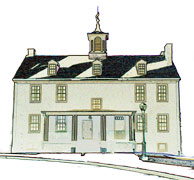


 | | | ||
 | | |||
 | | | | |
| | | |||
| | | |||
| Mapping Main Line History By David Schmidt Main Line Life originally published October 10-16, 2001 Most people think of maps as the means to find ourway geographically. They're how we find the corner ofLancaster Avenue and Conestoga Road. They tell ushow far we are from home or journey's end. But they are much more thanthat, or can be, if you care tolook at them. Maps also telltime and tell us what manknew when. Look at aSpanish or Portuguese mapof Columbus' day, and thedifference in precision between the WesternHemisphere and Europe is significant. Lookat a later map of North America, and there'smore accuracy, but the perspective is skewedtoward the ocean and where the Europeanscame from. Keeping maps is a way to keep track ofour history. In fact, they are as essential tounderstanding our past as any books, letters,papers, art or for that matter, buildings. Theytell us where our ancestors were and howthey got to where they were going. Some of the most interesting and usablemaps for people living on the Main Line arethe maps produced to document real estateand property lines the mile and a half, andeventually two miles, on either side of thePennsylvania Railroad. ForMain Liners, themost important arethose documentingthe run fromOverbrook to Paoli.On them is much ofthe history of theMain Line, as weknow it today. The Lower MerionHistorical Society usedsome of the proceedsfrom its book, 300 Years,about $7,000, to finance renovatingand completing itscollection of these surveymaps, some done by FranklinSurvey and others by A.H.Mueller, J.L. Smith and G.M.Hopkins. The society's collectionof these railroad surveymaps is probably the most completeof the area, including 12 mapbooks ranging from 1871 to 1961.Several were is bad shape, with bindingscoming apart and pages torn and missing. The only map book not in its collection isthe very rare 1948 book. Because thesebooks weren't replaced until 1961, fewprobably remained intact after constant usefor more than a decade and were thrownaway rather than saved. After determining what pages were missing,the society contacted Andrew and JudyAmsterdam, owners of Franklin Maps inKing of Prussia. They suppliedthese plates at areduced cost. According toorganization officials, theyare negotiating with theAmsterdams to acquire thatmissing 1948 book. With everything assembled,it was time to get thebooks repaired and protectedso they could continue toserve their original purpose.The books were sent to berestored in Greensboro,N.C., at EtheringtonConservation Center. That center was chosenafter the society contactedthe Pennsylvania Archivesand asked for assistance infinding someone to do thework on the oversizedbooks. So the maps wereshipped off to NorthCarolina where each pageand the 209 map plates weredeacidified, "folded encapsulated"and then rebound. According to the historical society'sarchivist, Farilyn Leopold, these maps aresome of the most referenced parts of the society'scollection. "They are wonderful andoffer such a sense of the history," she said."To me, the oldest are the most interestingbecause you can see the changing nature ofLower Merion." "These were real estate maps," Leopoldsaid. "They would use them to locate propertiesand even pencil in changes as propertieswere divided or expanded." As you look at them in sequence, you seethe history of the area unfold. "When youlook at the early books, you see these hugeestates and farms dating from Colonialtimes," Leopold said. "The estates were buildby the railroad tycoons, as they escaped thecity during the unhealthy summer months." "These maps are so helpful because theyshow the land, who owned it and a silhouetteof the house or buildings that stood on theproperty." They are some of the most usedfeatures of the society's collection as peoplecome in to learn about the history of theirhouse or property. "People will come in and try to determinethe history of their property or house,"Leopold said. "We will go back to the mapsjust before they think their house was built,for instance, and then track it up through thedecades until we find it. It's really fun towatch what happened to just one piece ofland over the years, and the owners are usuallydelighted." "But over the decades, you see thoseestates get dividedinto smallerand smallerproperties untilthe Main Linemoved completelyfrom beingrural to beingsuburban," shesaid. "[Themaps] were morethan a documentationof the area,though. Theyshowed whatwas changing isour lifestyles.More roads andmore peoplemeant that by the1950s, we hadbecome suburbanized." These mapswere useful forreal estate agentsto keep track ofthe changingface of the Main Line. The Realtors themselveswould literally draw on the pages inpencil to update the maps. The maps are now back at the AshbridgeHouse where people can once again look attheir property over the years or see what hashappened along Lancaster or Montgomeryavenues over the decades. But the society isn't stopping there.Beginning in November, the maps will beavailable online at the society's Web site.Internet surfers will be able to print out sectionsof a map. The maps have been dividedinto smaller sections that can be printed on ahome computer's printer. Eventually this digitized system may bethe best preservation move of the society, sothe society has separated the data from thedocuments. Because the maps are now digital,the value of their physical existence canbe preserved while at the same time anyonewho wants to can see how people a centuryago documented their lives and land. |